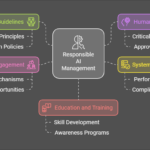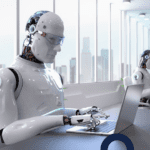How to Balance Automation and Human Touch in AI-Driven Project Management
In today’s fast-paced business environment, project managers face an unprecedented challenge: leveraging the power of artificial intelligence while preserving the irreplaceable human elements that drive project success. As someone who has implemented AI solutions across numerous projects while running my own business, I’ve learned that finding this balance isn’t just important—it’s essential for sustainable project success.
Understanding the Automation-Human Dynamic
The Role of AI in Modern Project Management
Artificial intelligence has revolutionized how we handle project management tasks. From predictive analytics for risk assessment to automated resource allocation, AI tools have become indispensable. However, the key to success lies not in how much you can automate, but in knowing what you should automate.
The Irreplaceable Human Element
While AI excels at data processing and pattern recognition, human project managers bring crucial elements to the table:
- Emotional intelligence and team motivation
- Creative problem-solving and contextual decision-making
- Stakeholder relationship management
- Cultural awareness and team dynamics understanding
How to Create a Balanced AI-Human Project Management Approach
Step 1: Audit Your Current Project Management Processes
Before implementing AI automation, conduct a thorough analysis of your existing processes:
- Document all recurring project management tasks
- Identify time-consuming manual processes
- Note which tasks require human judgment
- Map out communication workflows
- Assess team members’ comfort with technology
Step 2: Choose the Right Areas for Automation
Based on my experience implementing AI solutions, here are the most effective areas for automation:
High-Impact Automation Opportunities:
- Project scheduling and timeline management
- Resource allocation and capacity planning
- Status report generation
- Budget tracking and forecasting
- Routine communication follow-ups
Tasks Better Left to Humans:
- Strategic decision-making
- Team conflict resolution
- Complex stakeholder negotiations
- Creative problem-solving sessions
- Change management communications
A Practical Example: Implementing Hybrid Project Management
Let me share a real-world example of how to balance AI and human touch in a software development project.
Case Study: Agile Software Development Project
Initial Setup
- Implement AI-powered sprint planning tools
- Set up automated progress tracking
- Configure notification systems
Human Integration Points
- Daily stand-ups remain person-to-person
- Weekly retrospectives focus on team dynamics
- Regular one-on-one check-ins with team members
Step-by-Step Implementation Guide
- Assessment Phase (Week 1-2)
- Conduct team surveys on current pain points
- Map existing workflows
- Identify automation opportunities
- Tool Selection (Week 3)
- Research AI-powered project management tools
- Evaluate integration capabilities
- Consider team learning curve
- Pilot Implementation (Week 4-6)
- Start with one project stream
- Configure automated workflows
- Train team members
- Human Process Definition (Week 7-8)
- Establish communication protocols
- Define escalation paths
- Create feedback loops
- Full Integration (Week 9-12)
- Roll out to all project streams
- Monitor team adaptation
- Gather performance metrics
Best Practices for Maintaining the Balance
Technology Integration Guidelines
- Start Small and Scale Gradually
- Begin with simple automation
- Add features based on team feedback
- Monitor adoption rates
- Prioritize User-Friendly Solutions
- Choose intuitive interfaces
- Ensure mobile accessibility
- Provide comprehensive training
Human-Centric Approaches
- Regular Team Check-ins
- Schedule weekly face-to-face meetings
- Create safe spaces for feedback
- Address concerns promptly
- Emotional Intelligence Development
- Invest in leadership training
- Practice active listening
- Encourage open dialogue
Measuring Success: KPIs for Balanced Project Management
Quantitative Metrics
- Time saved through automation
- Project delivery accuracy
- Budget adherence
- Resource utilization rates
Qualitative Indicators
- Team satisfaction levels
- Stakeholder feedback
- Quality of communication
- Innovation and creativity metrics
Future Trends and Considerations
As AI technology continues to evolve, the balance between automation and human touch will remain crucial. Future developments to watch include:
- Natural language processing for more nuanced communication
- Emotional intelligence capabilities in AI systems
- Enhanced predictive analytics for risk management
- Improved collaboration tools
Conclusion: Striking the Right Balance
The key to successful AI-driven project management lies not in maximizing automation but in optimizing it. By thoughtfully combining AI capabilities with human expertise, project managers can create more efficient, effective, and enjoyable project environments for everyone involved.
Remember: Technology should enhance human capabilities, not replace them. The most successful project managers will be those who can harness the power of AI while nurturing the human connections that drive true project success.
Feel free to share your experiences with balancing automation and human touch in your project management practice in the comments below.





Leave a Reply